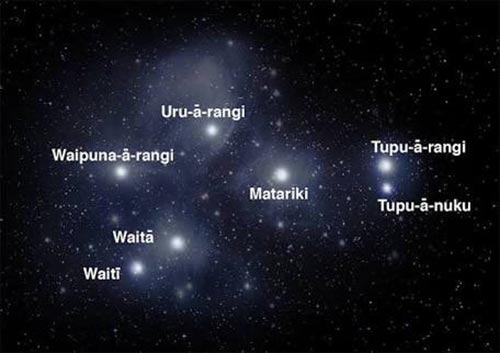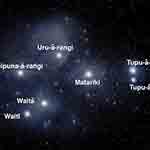
In the Southern Hemisphere, at the time of the winter solstice, a cluster of seven stars, called ‘the Pleiades’ in the Northern Hemisphere and ‘Matariki’ in Aotearoa New Zealand, becomes visible on the horizon just before dawn. For Maori, this marks New Year. It is a time to remember those who have died, particularly in the last year, for celebrating with harvested crops, seafood, and birds. Kites are flown close to the stars. And there might be hot-air balloons and fireworks.
Liturgical celebrations of Matariki clearly will use te reo Māori. Solstice threads can be incorporated, as well as traditions drawn from the biblical new year, Rosh Hashanah (Leviticus 23:24) including the blowing of the horn (or possibly appropriately the conch shell).
Some obvious hymns are:
Whakaria mai /How Great Thou Art
E te Atua —Alleluia Aotearoa 31
Where mountains rise to open skies — Alleluia Aotearoa 155
God of all time, all seasons of our living — Alleluia Aotearoa 49
Children’s activities can include making stars, kites,… Click here for ideas from the Rainbow Room Children at St Andrew’s on The Terrace.
During Matariki, we celebrate our unique place in the world. We give respect to the whenua on which we live, and admiration to our mother earth, Papatūānuku.
Throughout Matariki, we learn about those who came before us. Our history, our family, our bones.
Matariki signals growth. It’s a time of change. It’s a time to prepare, and a time of action. During Matariki, we acknowledge what we have and what we have to give.
Matariki celebrates the diversity of life. It’s a celebration of culture, language, spirit and people.
Matariki is our Aotearoa Pacific New Year.
Pope Francis is the first pope born in the Southern Hemisphere. It is a good time to be claiming and creating Southern Hemisphere ways of doing things.
What do you do for Matariki? What ideas do you have for it? How can we connect this with church celebrations? With home celebrations? With other contexts?
If you appreciated this post, do remember to like the liturgy facebook page, use the RSS feed, and sign up for a not-very-often email, …




I’m surprised that the Northern Hemisphere’s Winter Solstice didn’t end up as the New Year for the dominant cultures. It just seems a logical point from which to count the year. Instead we have this 1 JAN date and know that various cultures; Jewish, Chinese, Mayan, Maori, etc have their own at various times.
Matariki is a wonderful celebration! It is not something I grew up with or learnt about at school so it’s really great to see many of our schools learning about Matariki.
I think it could be a wonderful celebration in the Church. There’s really something in the message of new life coming even in the darkest, coldest of times and places.
There are so many fantastic resources for both children and adults out there exploring the story too.